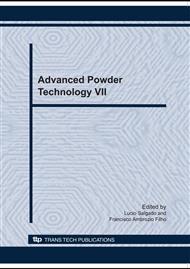p.860
p.866
p.873
p.879
p.885
p.893
p.899
p.904
p.910
Unidirectional Infiltration Method to Produce Crown for Dental Prosthesis Application
Abstract:
Alumina ceramics have been used in dental prosthesis because it is inert, presents higher corrosion and shear resistance when compared to metals, excellent aesthetic, and mechanical resistance. In this work it was produced an infrastructure material for applications in dental crowns, obtained by glass infiltration in alumina preforms. Various oxides, among that, rare-earth oxide produced by Xenotime, were melted at 1450°C and heat treatment at 700°C to obtain the glass (RE-glass). The alumina was pre-sintered at 1100°C cut and machined to predetermine format (unidirectional indirect infiltration) and finally conducted to infiltration test. The alumina was characterized by porosity (Hg-porosity and density) and microstructure (SEM). The glass wettability in alumina was determined as function of temperature, and the contact angle presented a low value (<90º), showing that glass can be infiltrated spontaneously in alumina. The infiltration test was conducted at glass melting temperature, during 30, 60, 180, 360 minutes. After infiltration, the samples were cut in longitudinal section, ground and polished, and analyzed by XRD (crystalline phases), SEM (microstructure) and EDS (composition).The REglass presents higher infiltration height when compared to current processes (direct infiltration), and homogeneous microstructure, showing that it is a promising method used by prosthetics and dentists.
Info:
Periodical:
Pages:
885-890
Citation:
Online since:
October 2010
Keywords:
Price:
Сopyright:
© 2010 Trans Tech Publications Ltd. All Rights Reserved
Share:
Citation:


